Wenao Ma
Senior Member, IEEE
Treatment Outcome Prediction for Intracerebral Hemorrhage via Generative Prognostic Model with Imaging and Tabular Data
Jul 24, 2023


Abstract:Intracerebral hemorrhage (ICH) is the second most common and deadliest form of stroke. Despite medical advances, predicting treat ment outcomes for ICH remains a challenge. This paper proposes a novel prognostic model that utilizes both imaging and tabular data to predict treatment outcome for ICH. Our model is trained on observational data collected from non-randomized controlled trials, providing reliable predictions of treatment success. Specifically, we propose to employ a variational autoencoder model to generate a low-dimensional prognostic score, which can effectively address the selection bias resulting from the non-randomized controlled trials. Importantly, we develop a variational distributions combination module that combines the information from imaging data, non-imaging clinical data, and treatment assignment to accurately generate the prognostic score. We conducted extensive experiments on a real-world clinical dataset of intracerebral hemorrhage. Our proposed method demonstrates a substantial improvement in treatment outcome prediction compared to existing state-of-the-art approaches. Code is available at https://github.com/med-air/TOP-GPM
3DSAM-adapter: Holistic Adaptation of SAM from 2D to 3D for Promptable Medical Image Segmentation
Jun 23, 2023



Abstract:Despite that the segment anything model (SAM) achieved impressive results on general-purpose semantic segmentation with strong generalization ability on daily images, its demonstrated performance on medical image segmentation is less precise and not stable, especially when dealing with tumor segmentation tasks that involve objects of small sizes, irregular shapes, and low contrast. Notably, the original SAM architecture is designed for 2D natural images, therefore would not be able to extract the 3D spatial information from volumetric medical data effectively. In this paper, we propose a novel adaptation method for transferring SAM from 2D to 3D for promptable medical image segmentation. Through a holistically designed scheme for architecture modification, we transfer the SAM to support volumetric inputs while retaining the majority of its pre-trained parameters for reuse. The fine-tuning process is conducted in a parameter-efficient manner, wherein most of the pre-trained parameters remain frozen, and only a few lightweight spatial adapters are introduced and tuned. Regardless of the domain gap between natural and medical data and the disparity in the spatial arrangement between 2D and 3D, the transformer trained on natural images can effectively capture the spatial patterns present in volumetric medical images with only lightweight adaptations. We conduct experiments on four open-source tumor segmentation datasets, and with a single click prompt, our model can outperform domain state-of-the-art medical image segmentation models on 3 out of 4 tasks, specifically by 8.25%, 29.87%, and 10.11% for kidney tumor, pancreas tumor, colon cancer segmentation, and achieve similar performance for liver tumor segmentation. We also compare our adaptation method with existing popular adapters, and observed significant performance improvement on most datasets.
Diffusion Model based Semi-supervised Learning on Brain Hemorrhage Images for Efficient Midline Shift Quantification
Jan 01, 2023



Abstract:Brain midline shift (MLS) is one of the most critical factors to be considered for clinical diagnosis and treatment decision-making for intracranial hemorrhage. Existing computational methods on MLS quantification not only require intensive labeling in millimeter-level measurement but also suffer from poor performance due to their dependence on specific landmarks or simplified anatomical assumptions. In this paper, we propose a novel semi-supervised framework to accurately measure the scale of MLS from head CT scans. We formulate the MLS measurement task as a deformation estimation problem and solve it using a few MLS slices with sparse labels. Meanwhile, with the help of diffusion models, we are able to use a great number of unlabeled MLS data and 2793 non-MLS cases for representation learning and regularization. The extracted representation reflects how the image is different from a non-MLS image and regularization serves an important role in the sparse-to-dense refinement of the deformation field. Our experiment on a real clinical brain hemorrhage dataset has achieved state-of-the-art performance and can generate interpretable deformation fields.
Test-time Adaptation with Calibration of Medical Image Classification Nets for Label Distribution Shift
Jul 09, 2022


Abstract:Class distribution plays an important role in learning deep classifiers. When the proportion of each class in the test set differs from the training set, the performance of classification nets usually degrades. Such a label distribution shift problem is common in medical diagnosis since the prevalence of disease vary over location and time. In this paper, we propose the first method to tackle label shift for medical image classification, which effectively adapt the model learned from a single training label distribution to arbitrary unknown test label distribution. Our approach innovates distribution calibration to learn multiple representative classifiers, which are capable of handling different one-dominating-class distributions. When given a test image, the diverse classifiers are dynamically aggregated via the consistency-driven test-time adaptation, to deal with the unknown test label distribution. We validate our method on two important medical image classification tasks including liver fibrosis staging and COVID-19 severity prediction. Our experiments clearly show the decreased model performance under label shift. With our method, model performance significantly improves on all the test datasets with different label shifts for both medical image diagnosis tasks.
Rapid model transfer for medical image segmentation via iterative human-in-the-loop update: from labelled public to unlabelled clinical datasets for multi-organ segmentation in CT
Apr 13, 2022



Abstract:Despite the remarkable success on medical image analysis with deep learning, it is still under exploration regarding how to rapidly transfer AI models from one dataset to another for clinical applications. This paper presents a novel and generic human-in-the-loop scheme for efficiently transferring a segmentation model from a small-scale labelled dataset to a larger-scale unlabelled dataset for multi-organ segmentation in CT. To achieve this, we propose to use an igniter network which can learn from a small-scale labelled dataset and generate coarse annotations to start the process of human-machine interaction. Then, we use a sustainer network for our larger-scale dataset, and iteratively updated it on the new annotated data. Moreover, we propose a flexible labelling strategy for the annotator to reduce the initial annotation workload. The model performance and the time cost of annotation in each subject evaluated on our private dataset are reported and analysed. The results show that our scheme can not only improve the performance by 19.7% on Dice, but also expedite the cost time of manual labelling from 13.87 min to 1.51 min per CT volume during the model transfer, demonstrating the clinical usefulness with promising potentials.
Hierarchical Deep Network with Uncertainty-aware Semi-supervised Learning for Vessel Segmentation
May 31, 2021



Abstract:The analysis of organ vessels is essential for computer-aided diagnosis and surgical planning. But it is not a easy task since the fine-detailed connected regions of organ vessel bring a lot of ambiguity in vessel segmentation and sub-type recognition, especially for the low-contrast capillary regions. Furthermore, recent two-staged approaches would accumulate and even amplify these inaccuracies from the first-stage whole vessel segmentation into the second-stage sub-type vessel pixel-wise classification. Moreover, the scarcity of manual annotation in organ vessels poses another challenge. In this paper, to address the above issues, we propose a hierarchical deep network where an attention mechanism localizes the low-contrast capillary regions guided by the whole vessels, and enhance the spatial activation in those areas for the sub-type vessels. In addition, we propose an uncertainty-aware semi-supervised training framework to alleviate the annotation-hungry limitation of deep models. The proposed method achieves the state-of-the-art performance in the benchmarks of both retinal artery/vein segmentation in fundus images and liver portal/hepatic vessel segmentation in CT images.
Consistent Posterior Distributions under Vessel-Mixing: A Regularization for Cross-Domain Retinal Artery/Vein Classification
Mar 16, 2021



Abstract:Retinal artery/vein (A/V) classification is a critical technique for diagnosing diabetes and cardiovascular diseases. Although deep learning based methods achieve impressive results in A/V classification, their performances usually degrade severely when being directly applied to another database, due to the domain shift, e.g., caused by the variations in imaging protocols. In this paper, we propose a novel vessel-mixing based consistency regularization framework, for cross-domain learning in retinal A/V classification. Specially, to alleviate the severe bias to source domain, based on the label smooth prior, the model is regularized to give consistent predictions for unlabeled target-domain inputs that are under perturbation. This consistency regularization implicitly introduces a mechanism where the model and the perturbation is opponent to each other, where the model is pushed to be robust enough to cope with the perturbation. Thus, we investigate a more difficult opponent to further inspire the robustness of model, in the scenario of retinal A/V, called vessel-mixing perturbation. Specially, it effectively disturbs the fundus images especially the vessel structures by mixing two images regionally. We conduct extensive experiments on cross-domain A/V classification using four public datasets, which are collected by diverse institutions and imaging devices. The results demonstrate that our method achieves the state-of-the-art cross-domain performance, which is also close to the upper bound obtained by fully supervised learning on target domain.
Multi-Task Neural Networks with Spatial Activation for Retinal Vessel Segmentation and Artery/Vein Classification
Jul 18, 2020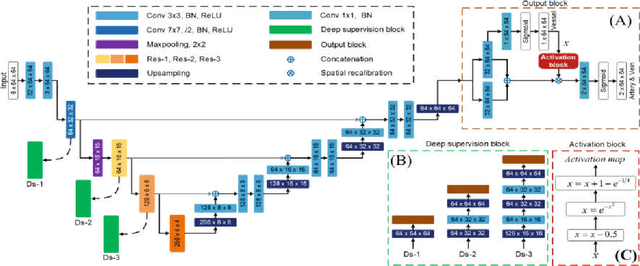

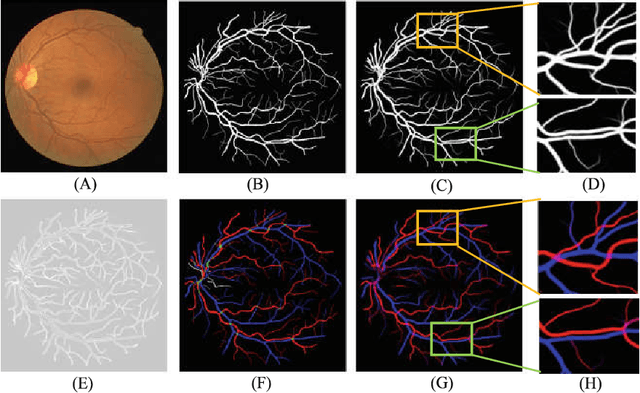

Abstract:Retinal artery/vein (A/V) classification plays a critical role in the clinical biomarker study of how various systemic and cardiovascular diseases affect the retinal vessels. Conventional methods of automated A/V classification are generally complicated and heavily depend on the accurate vessel segmentation. In this paper, we propose a multi-task deep neural network with spatial activation mechanism that is able to segment full retinal vessel, artery and vein simultaneously, without the pre-requirement of vessel segmentation. The input module of the network integrates the domain knowledge of widely used retinal preprocessing and vessel enhancement techniques. We specially customize the output block of the network with a spatial activation mechanism, which takes advantage of a relatively easier task of vessel segmentation and exploits it to boost the performance of A/V classification. In addition, deep supervision is introduced to the network to assist the low level layers to extract more semantic information. The proposed network achieves pixel-wise accuracy of 95.70% for vessel segmentation, and A/V classification accuracy of 94.50%, which is the state-of-the-art performance for both tasks on the AV-DRIVE dataset. Furthermore, we have also tested the model performance on INSPIRE-AVR dataset, which achieves a skeletal A/V classification accuracy of 91.6%.
Multi-Site Infant Brain Segmentation Algorithms: The iSeg-2019 Challenge
Jul 11, 2020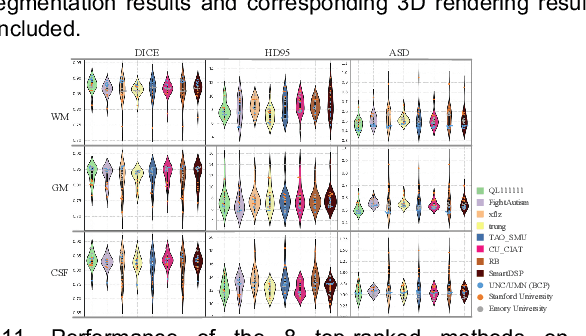
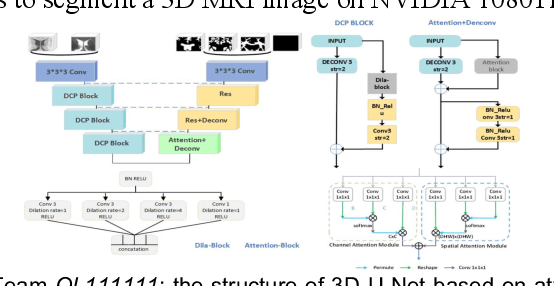
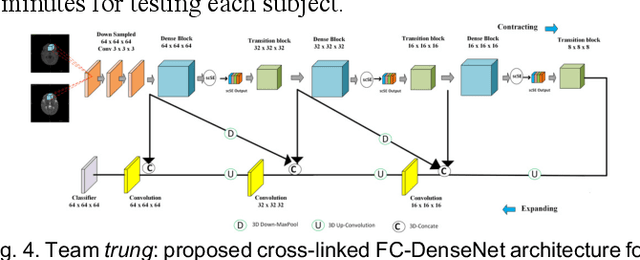
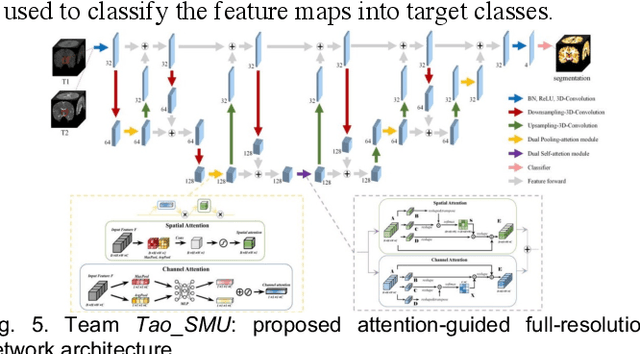
Abstract:To better understand early brain growth patterns in health and disorder, it is critical to accurately segment infant brain magnetic resonance (MR) images into white matter (WM), gray matter (GM), and cerebrospinal fluid (CSF). Deep learning-based methods have achieved state-of-the-art performance; however, one of major limitations is that the learning-based methods may suffer from the multi-site issue, that is, the models trained on a dataset from one site may not be applicable to the datasets acquired from other sites with different imaging protocols/scanners. To promote methodological development in the community, iSeg-2019 challenge (http://iseg2019.web.unc.edu) provides a set of 6-month infant subjects from multiple sites with different protocols/scanners for the participating methods. Training/validation subjects are from UNC (MAP) and testing subjects are from UNC/UMN (BCP), Stanford University, and Emory University. By the time of writing, there are 30 automatic segmentation methods participating in iSeg-2019. We review the 8 top-ranked teams by detailing their pipelines/implementations, presenting experimental results and evaluating performance in terms of the whole brain, regions of interest, and gyral landmark curves. We also discuss their limitations and possible future directions for the multi-site issue. We hope that the multi-site dataset in iSeg-2019 and this review article will attract more researchers on the multi-site issue.
Multi-sequence Cardiac MR Segmentation with Adversarial Domain Adaptation Network
Oct 28, 2019

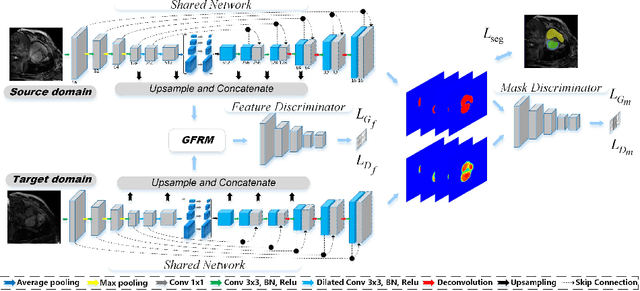
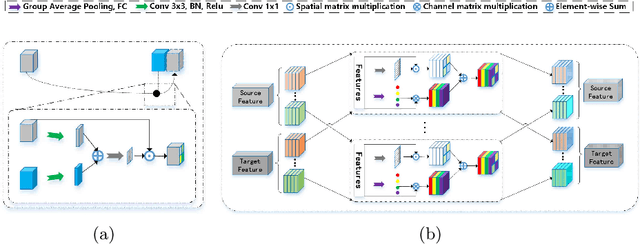
Abstract:Automatic and accurate segmentation of the ventricles and myocardium from multi-sequence cardiac MRI (CMR) is crucial for the diagnosis and treatment management for patients suffering from myocardial infarction (MI). However, due to the existence of domain shift among different modalities of datasets, the performance of deep neural networks drops significantly when the training and testing datasets are distinct. In this paper, we propose an unsupervised domain alignment method to explicitly alleviate the domain shifts among different modalities of CMR sequences, \emph{e.g.,} bSSFP, LGE, and T2-weighted. Our segmentation network is attention U-Net with pyramid pooling module, where multi-level feature space and output space adversarial learning are proposed to transfer discriminative domain knowledge across different datasets. Moreover, we further introduce a group-wise feature recalibration module to enforce the fine-grained semantic-level feature alignment that matching features from different networks but with the same class label. We evaluate our method on the multi-sequence cardiac MR Segmentation Challenge 2019 datasets, which contain three different modalities of MRI sequences. Extensive experimental results show that the proposed methods can obtain significant segmentation improvements compared with the baseline models.
 Add to Chrome
Add to Chrome Add to Firefox
Add to Firefox Add to Edge
Add to Edge